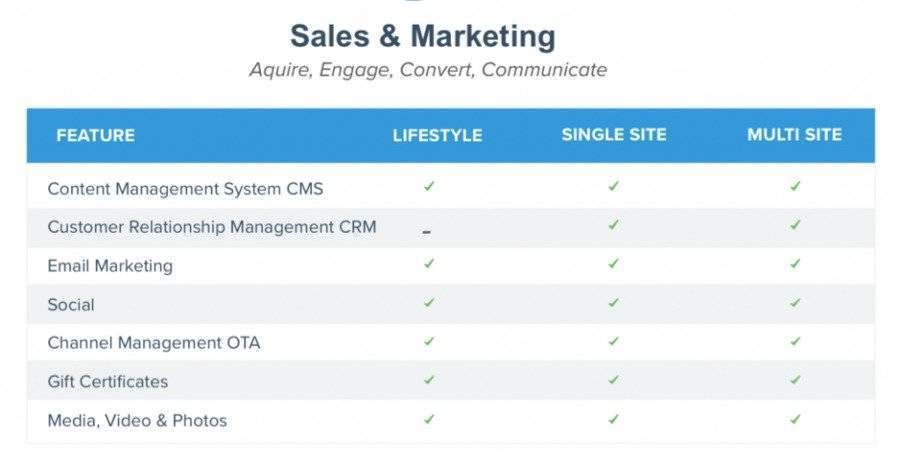You know that feeling you get when something just works? Or you find something right where you left it? This is the sensation you might experience when you start using a tourism CRM software.
One of the biggest perks of the tours and activities business is meeting guests from all over the world. It’s likely why so many of you choose this line of work in the first place.
But what if you could get to know your guests better without having to jot down notes or hop on a call with each one?
Many tour operators know the importance of having a booking system, but might not be sure what Customer Relationship Management System (CRM) is and how it adds value.
Tourism CRM software can track everything you need to run your tours and activities. Your system can keep you organized by tracking customer names and email addresses along with booking history, email communications, staff notes and sales.
When evaluating a Customer Relationship Management (CRM) — you’re looking to manage the relationship you have with current and prospective customers.
How to determine what you need in tourism CRM software
When choosing the best tour operator software, start by thinking of ways you might improve interactions with your customers. Ultimately, a CRM acts as an efficient method for tracking guests, capturing data and populating customer contact information.
Detail the essential components of what someone needs to know to get started and pick up where you left off. To help give you a sense of what to include, imagine what you’d include if someone had to pick up and run your tour business tomorrow.
There are numerous benefits to having a CRM including more efficient workflows, guest communication and more time to dedicate to your online marketing efforts.

Why do you need tourism CRM software
With all information made easily accessible, you’ll be better able to serve your customers and personalize their experience. In addition, you can evaluate your customer data, clicks, interactions and spot trends over time.
One major benefit to a CRM is having centralized hub accessible by anyone in your tour business. This means all key information isn’t being stored in a coveted binder or scribbled on post-it notes that might get lost.

A CRM alleviates many of the manual tasks in your tour business. For more insight on how a CRM can support your business, check out the Podcast from Agents of Change with Steph Nissan.
Freeing up your time is allowing you to focus on your online marketing efforts. Plus, you can use data stored in your CRM to help you make strategic decisions when promoting your business on different channels.
Most CRMs require you to learn the software to maximize the benefit you see from it. Your time is valuable, which means the effort you put into setting up tourism CRM software can come back to you in spades.
How tour operator software works with integrations
Let’s say you process 5000 bookings per year, you have multiple touch points you share with your customers.
Assuming you work five days per week, you have approximately eight hours per day to do everything. Even the rough math demonstrates that this isn’t a lot of time to dedicate to each individual guest. This is where a CRM can take some of the workload off your plate.
Just imagine how your days could look if you automated 50-80% of your daily administrative tasks. Whew, it’d be like taking a big breath of fresh air!
Look at tour operator software as an opportunity to free yourself from some of the manual and repetitive aspects of running a tour business. One helpful option with Checkfront is automatically creating contacts from new bookings using our Zapier integration.
Truthfully, when you find a tour operator software that integrates with your online booking system, it can grant you more time to focus on growing your tour business.

The best tourism CRM software
There are a handful of CRMs available for tour operators looking to digitize customer interactions.
The following CRMS are designed to collect customer information, offer email marketing and create workflows that streamline your tour business communications. Many will offer a free or limited-time trial option so you can give them a test run before committing on a monthly or annual basis.
Tourism CRM software options:
Ultimately sales and marketing is one segment of tour operator software. The goal of having a system in place is to communicate and engage with prospects and customers effectively.
Here are a few areas to evaluate when narrowing your search for suitable tour CRM software.
Content Management System (CMS)
While your daily to-do list may be lengthy, the tasks you tackle in a day make your tour business work.
When starting a tour business, implementing a content management system can make your workflow much more efficient.
A CMS allows you to add, create, edit, organize and publish your website content. You can then choose from various themes and use them to house all of your digital assets. Then you personalize the template to match your brand and add your content, including web copy and images.
Aim to set up your website with SEO best practices in mind so your business appears high on the search results. This means adding in keywords that match what your audience is searching for.
Your website is your most important online sales channel. And it happens to be the first impression most guests will have with your business.
A functional content management system lets you import content designed to impress and convert your website users. And once you’ve connected with guests, you need to have a way of continuing the conversation. This is where email marketing and CRMs can merge into a consistent and effective workflow.
Email Marketing
As one of the most accessible and easy-to-use methods for connecting with your customers, email marketing plays a key role.
When visitors come to your website and opt to subscribe to your list, they will expect an email confirmation. You’ve already done the hard part by attracting them to your website and converting them into paid guests, you can continue the communication with your emails.
Email marketing allows you to engage with past and future customers as a powerful tool to promote your tours and activities. Email is fast, inexpensive and possible to send en masse.
For example, tourism companies will often notify local subscribers of an upcoming promotion, new tour release or limited-time promo code that they can apply to future visits. The continued connectivity can inspire guests and help to drive direct online bookings.
But there are plenty of opportunities to grow your reach outside of bookings made through your website, which is where OTA’s can be useful for tour operators.

Channel management and online distribution
To broaden your reach, you may want to explore additional distribution channels. Viator, Expedia Local Expert, and GetYourGuide are online travel agents (OTA’s). They exist to help with marketing tour and activity businesses in front of travelers looking to book.
These online channels can help connect with new market segments, further streamlining your marketing efforts. While there’s plenty of opportunity with direct bookings, consider using online distribution channels to help with promoting your business to a wider audience.
Then, the Destination Marketing Organizations (DMO’s), and finally, you have the Destination Management Companies (DMC’s). On top of that, you might have partnerships with other local companies where you send each other referrals.
Channel Management allows you to distribute your tours to all of these partners. The benefit to you is in not having to worry about double-bookings while ensuring everyone’s paid their share and commissions.
Another segment of income generation is in forward-thinking purchases. For instance, being able to provide gift certificates can support a more even cash flow throughout the year.
Gift certificates
Businesses have long used gift certificates to encourage sales — especially since COVID became a part of our regular vocabulary.
With many online reservation systems, you can also create digital gift cards. Customers can purchase and send them to their friends and family over email or social media.
You can also generate coupon codes to share with your contact lists for promotions. To use digital gift certificates, you’ll need to create and track each unique code and accept them at checkout.

Adding travel photos and video content
Travel shopping is an incredibly visual experience. People don’t want to read about the place they are visiting. They want to see it for themselves. As a result, images and videos can be one of the most influential factors of travel shopping.
Help prospective customers imagine themselves in the experience by using powerful visuals to make a good impression. It’s wise to have a photographer or someone with a smartphone capturing photos throughout your tours. Your guests can share these images, which can help with word-of-mouth travel marketing.
If you look at the majority of Facebook and Google ads, they usually have a visual attached. The main reason photos and videos are essential in marketing is how they invoke an emotional reaction.
Final thoughts
It’s important for you to feel empowered to run your tour business with tourism CRM software. There are so many intricacies with each tour operation that you need to choose a system that’s intuitive for you, your staff and your operation. If you’re looking for more tools to help run your business, you can also evaluate the different options for tour operator credit card processing and tour operator software solutions.
With a CRM, you can maintain connections with customers in a timely way, providing peace of mind and value throughout the customer journey. By staying top of mind and engaged with your target audience, they’ll be more inclined to buy from you.
Aim to engage with travelers on a regular basis and make it easy by exploring whether a CRM can support you with your tour business goals.
Looking for helpful ways to add value to your tour and activities?

Subscribe to the Checkfront Newsletter
Read new tips on how to get more bookings every month.



